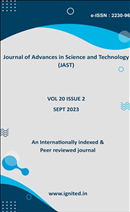Enhancing Manufacturing Quality Through Statistical Process Control
DOI:
https://doi.org/10.29070/3xd2x680Keywords:
Manufacturing, Quality, SPCAbstract
In the manufacturing industry, statistical process control, often known as SPC, is a strong instrument that can improve both the quality of the product and the efficiency of the process. It comprises the utilization of statistical approaches for the purpose of monitoring and controlling a process in order to guarantee that it functions effectively and generates products that are of a consistently high grade. The statistical process control (SPC) method enables producers to identify variances, trends, and irregularities that may have an impact on product quality. This is accomplished by collecting and analyzing data from the production process. It is possible for manufacturers to discover and rectify problems in real time with the assistance of statistical process control (SPC), which is accomplished through the utilization of control charts, process capability analysis, and other statistical approaches. This results in decreased waste, greater productivity, and increased customer satisfaction. This article examines the fundamentals of statistical process control (SPC), as well as its application in manufacturing environments and the advantages it offers in terms of improving both product quality and process performance.
Downloads
References
Gulbay, M., Kahraman, C., and D. Ruan (2004). a -cut Fuzzy Control Chart for Linguistic Data, International Journal of Intelligent Systems, 19, 1173-1196.
Hawkins, D.M (1974). The Detection of Errors in Multivariate Data, Journal of the American Statistical Association, 69, 340- 344.
Hawkins, D.M (2020). Multivariate Quality Control Based on Regression-Adjusted Variables, Technometrics, 33, 61-75.
Hawkins, D.M (2014). Regression Adjustment for Variables in Multivariate Quality Control, Journal of Quality Technology, 25, 409-412.
Holmes, D.S., and A.E Mergen (2014). Improving the performance of the T 2 control chart, Quality Engineering, 5, 619- 25.
Hsu, H.M., and Y.K Chen (2001). A fuzzy reasoning based diagnosis system for X control charts, Journal of Intelligent Manufacturing, 12, 57-64.
Huh, Ick (2010). Multivariate EMWA Control Chart and Application to a Semiconductor Manufacturing Process.
Hunter, J.S (2016). The Exponentially Weighed Moving Average, Journal of Quality Technology, Vol. 18.
Irfan Ertugrul and Esra Aytac (2019). Construction of Quality control charts by using probability and fuzzy approaches and an application in a textile company, Journal of Intelligent Manufacturing, 20, 139-149.
Ishan Kaya and Cengiz Kahraman (2010). Process capability analyses based on fuzzy measurement and fuzzy control charts, Expert System with Applications, 38, 3172-3184.
Jackson, J.E (1985). Multivariate Quality Control, Communication in Statistics - Theory and Methods, 14, 2657- 2688.
Jackson, J.E., and G.S Mudhalkar (1979). Control procedures for residuals associated with principal component analysis, Technometrics, 21, 341-349.
Jackson, J.E., and R.H Morris (2019). An application of multivariate quality control to photographic processing, Journal of the American Statistical Association, 52, 186-199.
Jiang, W (2004). Multivariate Control Chart for Monitoring Autocorrelated Processes, Journal of Quality Technology, 36, 4, 367-379.
Jobe, J.M., and M. Pokojovy (2019). A multistep, Cluster-Based Multivariate chart for Retrospective Monitoring of Individuals, Journal of Quality Technology, 41(4), 323-339.
Joel K. Jolayemi (2018). A power function model for determining sample size for the operations of multivariate control charts, Computational Statistics and data analysis, 20, 633-641.






